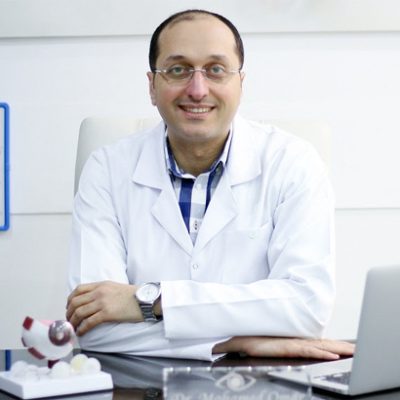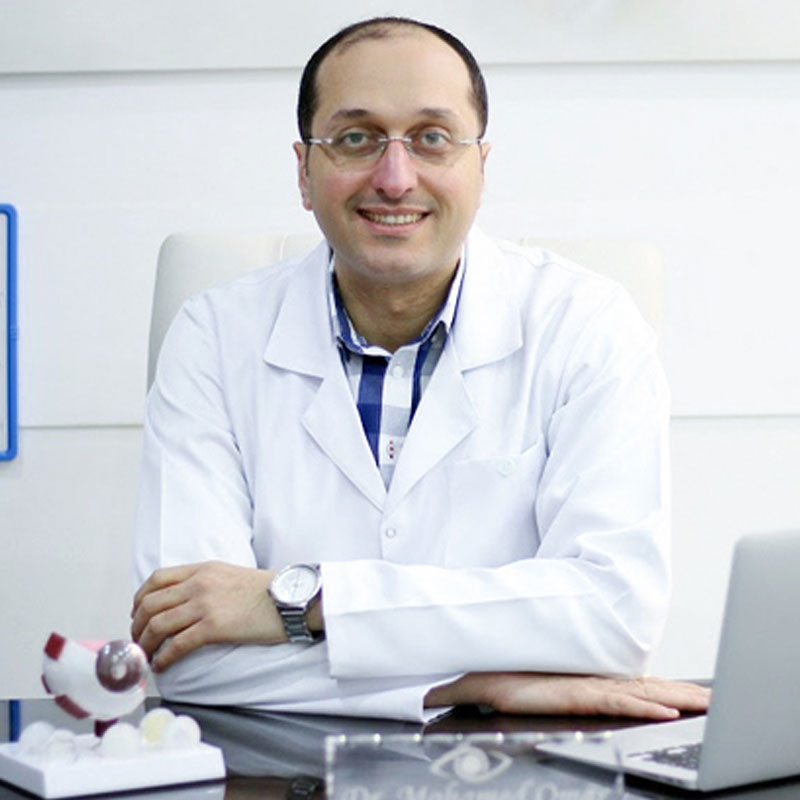The Best Ophthalmologist in Egypt
- The prestigious academic degree he obtained, as he is a professor of ophthalmology and surgery at the Faculty of Medicine, Ain Shams University.
- His professional specialty as a consultant in corneal and cataract surgeries, laser vision correction, and lens implantation for more than 21 years.
- His important scientific and research contributions in the field of ophthalmology and eye surgery. These scientific contributions were published in the best specialized international scientific journals and are considered a reference for many doctors and researchers.
- Being an active member in many prestigious academic and scientific bodies around the world.
- His extensive practical and surgical experience, in addition to his success in performing a wide range of eye surgeries.
- Dr. Mohamed has a good reputation among patients and all his fellow ophthalmologists and students.



Trust Score 4.9 (Based on 459+ reviews)
Eye surgeries are considered delicate surgeries that require a highly experienced, competent, and skilled surgeon and ophthalmologist to perform.
Dr. Mohamed Omar Youssef (professor of ophthalmology at Ain Shams University and consultant in corneal and cataract surgeries and laser vision correction) stands out among the best eye surgeons in Egypt and the Arab world. Especially after he received the Best Eye Surgeon in the World award at the ASCRS conference in San Diego, California, USA in 2015.
- He is a member of the American Academy of Ophthalmic Surgeons (AAO).
- Member of the American Society of Cataract and Refractive Surgery (ASCRS).
- Member of the European Society of Cataract and Refractive Surgery (ESCRS).
- He is also a Fellow of the Royal College of Ophthalmology (FRCS).
- Fellow of the International Council of Ophthalmology (ICO).
At Dr. Mohamed Omar Youssef Clinics, we are proud to provide the best eye care services in Egypt and the Arab world. The doctor is distinguished by his long history in the field of ophthalmology, his extensive experience, and his superior skill in eye surgery. This long experience makes him the Best Ophthalmologist in Egypt according to many people.
At Dr. Mohamed Omar Center, we are committed to providing inclusive and unique care to all patients, through systematic and accurate eye examinations using the latest medical equipment.
We are keen to provide a modern, comfortable environment equipped with the latest medical technology. Our team works very efficiently to ensure patients' comfort, achieve the best treatment results, and ensure that they receive the best medical service with Dr. Mohamed, the best ophthalmologist in egypt.

Dr. Mohamed Omar Yousef Center
An upscale and exceptional service in the field of ophthalmology and surgery.
Extreme precision
Experience
The best
Center Services
Dr. Mohamed Omar Youssef specializes in treating keratoconus disease using various methods, such as total corneal transplantation, partial corneal transplantation, and ring transplant for corneal fixation. Dr. Mohamed obtained a doctorate in this particular specialty.
Keratoconus is a common disease in Egypt and the world. It causes a gradual weakening of the cornea that usually begins at an early age or in adulthood as a result of weak connections between the collagen fibers that make up the cornea.
A cone-shaped cornea leads to an increase in the degree of convexity of the cornea and a change in its surface from a dome-shaped to a cone-shaped one, which reduces its thickness.
This disease also results in distortion of the cornea, blurred vision with glasses, in addition to a high degree of astigmatism.
There are several methods for treating keratoconus, such as:
- Collagen Cross Linking
Collagen cross-linking is the first procedure to treat keratoconus in its early stages. The main goal of this procedure is to stop the deterioration of the disease by strengthening the surface of the cornea using riboflavin technology.
This operation is performed by removing the epithelial cells in the cornea’s front surface and then placing drops of riboflavin (vitamin B2) on the surface of the cornea. Then, UV rays are directed at certain degrees to the surface of the cornea to activate the effect of the riboflavin drops and increase the bonds forming the surface of the cornea (collagen bonds). After these procedures, the corneal tissue strengthens, and keratoconus progression stops completely.
- Intra Corneal Rings
Implanting rings for keratoconus is one of the most important operations that contribute to treating the problems resulting from keratoconus progress. This action is taken if the degree of corneal curvature exceeds normal levels when the patient’s vision measurement changes at frequent intervals.
This procedure is done by implanting specialized rings inside the corneal tissue to modify its surface and get rid of its large degree of convexity. Intra Corneal Rings significantly contribute to improving the patient’s level of vision over time.
This step is usually followed by keeping the new cornea in place using stitches, called sutures.
Photorefractive Keratectomy (PRK)
Photorefractive Keratectomy is one of the most advanced procedures used in keratoconus. This procedure allows the surface to be reshaped first with a corneal imprint laser, followed by traditional keratoconus procedures relying on riboflavin drops and ultraviolet light.
This procedure contributes to effectively correcting vision and to preventing the progress of keratoconus again.
- Corneal transplantation
Corneal transplantation is the last procedure Dr. Muhammad Omar Youssef resorts to when keratoconus progresses significantly, or when central opacity appears on the surface of the cornea.
There are 2 types of corneal transplant:
- Total corneal transplants: This type of corneal transplant is the most famous one. Dr. Mohamed Omar replaces the cornea with another cornea from a donor. This cornea is obtained from the Cornea Bank in the United States according to special specifications.
- Partial corneal transplantation: It is the newest and most important method of corneal transplantation. Dr. Mohamd Omar replaces only the damaged layers of the cornea, without replacing the entire layers of the cornea. This helps in speed up recovery, increasing the operation success rate, and reducing rejection rates.
Instructions After Corneal Surgeries
Dr. Mohamed Omar Youssef – the best ophthalmologist in egypt – points out a set of important instructions that must be adhered to after corneal operations.
These instructions include from The Best Ophthalmologist in Egypt:
- Avoid rubbing the eyes: All of the previous procedures are performed on the surface of the cornea. This exposes the surgery to failure if the eyes are rubbed incorrectly
- Use all prescribed drops at the specified times: These drops include antibiotic drops, anti-inflammatory drops, and lubricating eye drops. The first one protects against infection, the second reduces pain and inflammation after operations, and the third protects the eye from dryness that may delay recovery from the operation.
- Make sure to schedule regular visits to the doctor to monitor the condition of your cornea after the operation to avoid any complications that may occur.
Dr. Mohamed Omar Youssef, the best ophthalmologist in Egypt, performs cataract removal surgery using laser or phaco in less than 5 minutes under local anesthesia.
Dr. Mohamed Omar Youssef is widely regarded as the top ophthalmologist in Egypt, particularly due to his outstanding scientific contributions globally and his innovation of a new surgical technique in the development of iris repair surgeries during cataract surgery (Single Suture Customized Loop for Huge Iridodialysis Repair During Phacoemulsification), earning him the recognition of having the best surgical technique worldwide at the American Society of Cataract and Refractive Surgery conference in 2015.
Cataract is the clouding of the eye’s lens, leading to blurry vision and progressive vision impairment. Cataracts typically start in a small part of the lens and gradually spread, causing vision weakness or a feeling of fog obstructing vision. In such cases, surgical intervention is necessary to remove the cloudy lens and implant a new lens in its place.
Cataract Types and Causes
There are several types of cataracts, differing in their causes, as follows:
- Senile cataracts, the most common type, occurring naturally with aging.
- Congenital cataract, resulting from genetic factors or viral infection during pregnancy.
- Cataracts resulting from untreated eye diseases, often due to neglecting treatment for retinal detachment or uveitis.
- Cataracts caused by long-term use of corticosteroids.
- White water may also result from direct eye trauma.
Medical Techniques for Treating Cataracts
- Phacoemulsification (Ultrasound Waves): In this technique, a small incision is made near the cornea, and then ultrasound waves are directed at the opaque lens to break it up, followed by its removal and thorough cleaning of the lens place. This procedure does not typically cause astigmatism after its completion.
- Femto Cataract: Similar in goal to phacoemulsification, but with a different technique for lens fragmentation, relying entirely on femtosecond laser technology for either lens fragmentation or astigmatism correction during the procedure.
- Surgical Cataract Operation: Unlike the previous two procedures, this operation involves completely removing the lens through a relatively large surgical incision near the cornea. Recovery from this procedure typically takes longer compared to phacoemulsification or femto cataracts.
This procedure is only resorted to when the cataracts in the eye are dense or difficult to remove using the previous two methods.
Book your appointment now with the best doctor for cataract operation.
Can Cataracts be Treated Without Surgery?
Many people fear entering operating rooms, especially if it involves the eye, a sensitive organ that can be painful if even a speck of dust enters it. Therefore, they seek easy solutions first, such as those looking for non-surgical treatments for cataracts, whether through eye drops or oral medications.
In fact, at present, there is no treatment for cataracts other than the surgical procedures mentioned earlier.
To make you reassured, Dr. Mohamed Omar Youssef – the best ophthalmologist in egypt– confirms that these operations are completely safe, and there are no serious complications if performed under the supervision of a skilled and experienced physician.
What Is the Success Rate of Cataract Surgery?
The success rate of cataract surgery using phaco or laser techniques is around 99%, while the success rate of traditional surgery for treating cataracts is around 95%. This rate increases when the operation is performed by a proficient doctor and decreases if performed by a doctor lacking sufficient practical and scientific experience.
When it comes to vision correction surgeries, it’s not just about choosing from a list of procedures that the patient feels might suit them or fix their vision problems. It requires experience, professional integrity, and a qualified doctor to perform these surgeries after selecting the best option for the patient, ensuring the highest visual efficiency, and minimizing any postoperative complications.
At Dr. Mohamed Omar Youssef’s center, we have the latest types of medical devices used in vision correction surgeries, prepared to perform all types of these surgeries under the supervision of an expert and distinguished medical team.
The most important surgeries performed by Dr. Mohamed Omar Youssef are:
- Contoura Vision LASIK: This is one type of laser that corrects vision defects according to the unique contours of the surface of the cornea, treating associated vision problems such as various visual distortions.
- Custom LASIK and Femto Custom LASIK: These procedures rely on customizing a laser profile for each patient, then applying this laser to the cornea to correct vision and treat associated problems such as night vision weakness, color contrast deficiency, and various visual distortions, allowing the patient to achieve the highest visual efficiency.
- Femto-LASIK: This procedure relies on the femto laser to cut and lift the surface layer of the cornea, then applying the excimer laser directly to the corneal surface to correct vision defects.
- Femto-Smile: This procedure is one of the most important surgeries performed to treat severe myopia and cases with thin corneas. In this procedure, the surface layer of the cornea is not lifted, but the femto laser is used to separate the inner corneal layers, then the desired layer (such as the lens) is extracted through a small incision in the cornea’s side.
- Surface Laser: This procedure is performed for cases suffering from mild vision weakness, also without lifting the surface layer of the cornea. It involves only removing the epithelial cells lining the corneal surface, then applying Custom LASIK or OptiLASIK laser to the cornea to correct vision defects.
Will vision return to 6/6 after LASIK surgeries?
That depends on the nature of the surgery performed on the patient and the visual defects they had. If the patient only suffers from refractive errors and to a mild degree, the likelihood of their vision returning to 6/6 after the surgery is higher.
However, if they have visual distortions and haven’t undergone one of the specialized surgeries for treating visual distortions alongside refractive errors, they may still face some difficulties in vision.
Generally, vision returns to 6/6 in most cases undergoing LASIK surgeries, but on the condition of selecting the most suitable surgery for the patient and undergoing it by the Best Ophthalmologists near you in Egypt.
Dr. Mohamed Omar Yousef performs lens implantation surgery to correct Myopia and farsightedness. It’s a simple procedure that takes less than 5 minutes under local anesthesia and serves as an excellent alternative to laser vision correction for cases unsuitable for such procedures.
Difference between Lens Implantation and Lens Replacement:
Lens Implantation: This type of procedure is for patients under 40 years old, where the eye muscles responsible for focusing have weakened. In this process, the new lens is implanted in front of the original lens directly.
ICL lenses, implanted on the original lens, are considered the best type of lenses. The procedure takes only about 5 minutes and has helped avoid complications associated with other lens implantation methods, such as damage to the corneal endothelium. These lenses are permanent and are not rejected by the body.
Lens Replacement: In contrast, this procedure involves removing the old lens and replacing it with an artificial one, suitable for individuals over 40 whose eye muscles have weakened.
Best Types of Lenses Implanted in Front of the Eye Lens:
The ICL lens is the best of these lenses. It’s flexible and lightweight, making it very easy and quick to implant, taking no more than five minutes under local anesthesia. The body accepts it for life, and it’s never rejected by the immune system. Additionally, this lens is not visible to the naked eye after implantation, thus not altering the natural appearance of the eye.
As the lens is soft and flexible, it can be folded easily and inserted into the eye through a very small incision that is not visible to the naked eye. Therefore, the procedure is performed under a surgical microscope, and the lens insertion takes less than a minute. This foldable lens automatically unfolds upon entering the eye, taking its final position between the iris and the natural lens, thereby correcting vision defects easily.
Newest Types of Lenses That Can Be Implanted Instead of the Eye Lens:
- Monofocal IOL: This lens type is the most common and widely used in lens implantation surgeries, aiding in getting rid of glasses for long distances while the patient still needs glasses for close distances.
- Toric IOL: This lens type is designed specifically to correct astigmatism.
- Multifocal IOL: This lens type completely eliminates the need for prescription glasses and contact lenses, enabling clear vision for both near and distant objects simultaneously, although the brain needs some time to adapt to the new lenses.
Can I choose the type of lens I want?
The responsibility of choosing the type of implanted lens lies with the best ophthalmologist in egypt, based on accurate diagnosis before the procedure, knowing all the details about the patient’s vision problems, their occupation, and lifestyle, as not all types of lenses suit all patients. However, if several types of lenses are equally suitable for implantation, the doctor guides the patient in choosing the appropriate type, explaining the features and drawbacks of each type.
إن التخصص الدقيق للدكتور محمد عمر يوسف هو أمراض القرنية المخروطية وعلاجها بالطرق المختلفة، مثل زراعة القرنية الكلية، والزراعة الطبقية للقرنية، وزراعة الحلقات وتثبيت القرنية. وقد حصل على شهادة الدكتوراه في هذا التخصص.
والقرنية المخروطية هو مرض منتشر في مصر والعالم يحدث فيه ضعف تدريجي في القرنية يبدأ عادة في السن الصغير أو عند البلوغ نتيجة ضعف الروابط بين ألياف الكولاجين المكونة للقرنية مما يزيد من درجة تحدبها ويتحول سطحها من الشكل كامل الاستدارة إلى شكل قمع أو مخروط مع ضعف متزايد فى سمك القرنية،مما يؤدى إلى تشوه وعدم وضوح الرؤية بالنظارة الطبية مع وجود استيجماتيزم عالى وغير منتظم.
هناك طرق عدة للعلاج القرنية المخروطية مثل:
عملية تثبيت القرنية Collagen Cross Linking
تعتبر عملية تثبيت القرنية هي أولى إجراءات علاج القرنية المخروطية في مراحلها المبكرة، ويعتبر الهدف الرئيسي منها هو إيقاف تدهور المرض من خلال تقوية سطح القرنية باستخدام تقنية مادة الريبوفلافين.
وتُجرى هذه العملية عن طريق إزالة الخلايا الطلائية المبطنة لسطح القرنية الأمامي، ومن ثم وضع قطرات الريبوفلافين (فيتامين ب2) على سطح القرنية. ويتبع ذلك تسليط الأشعة فوق البنفسجية بدرجات معينة على سطح القرنية حتى ينشط مفعول قطرات الريبوفلافين، ويؤدي إلى زيادة الروابط المكوّنة لسطح القرنية (روابط الكولاجين).. وبمجموع هذه الإجراءات يقوى نسيج القرنية، ويتوقف تطور مرض القرنية المخروطية تمامًا.
عملية زراعة الحلقات Intra Corneal Rings
إن عملية زراعة الحلقات للقرنية المخروطية هي واحدة من أهم العمليات التي تساهم في علاج المشكلات الناجمة عن تطور القرنية المخروطية، أي في الحالة التي تكون فيها درجة تحدب القرنية قد ازداد عن المعدلات الطبيعية، بحيث يتغير قياس النظر للمريض في فترات متقاربة.
وتُجرى هذه العملية عن طريق زراعة حلقات مخصصة داخل نسيج القرنية لتعديل سطحها والتخلص من درجة التحدب الكبيرة التي صارت موجودة فيها بسبب مرض القرنية المخروطية، مما يساهم في تحسن مستوى الرؤية لدى المريض مع مرور الوقت.
وعادة ما يُتبع هذا الإجراء عملية تثبيت القرنية حتى لا يتطور المريض مرة أخرى.
“تعرف على: تكلفة زراعة الحلقات في مصر“
الليزر السطحي ببصمة القرنية مع تثبيت القرنية ( Athen‘s Protocol )
يعتبر بروتوكول أثينا أحد الإجراءات المتطورة التي تستخدم في تثبيت القرنية، ويسمح هذا الإجراء بإعادة تشكيل سطح أولاً بواسطة ليزر بصمة القرنية، ومن ثم يتبع ذلك إجراءات تثبيت القرنية المخروطية التقليدية، والتي تعتمد على قطرات الريبوفلافين والأشعة فوق البنفسجية.
ويساهم هذا الإجراء في تصحيح النظر بنسبة ما، بجانب منع تطور مرض القرنية المخروطية مرة أخرى.
زراعة (ترقيع) القرنية Corneal Transplantation
زراعة القرنية هي الخيار الأخير الذي يلجأ له الدكتور محمد عمر يوسف في حال تطور مرض القرنية المخروطية بصورة كبيرة، أو حال وجود عتامات مركزية على سطح القرنية.
وتنقسم طرق زراعة القرنية إلى نوعين:
زراعة القرنية الكلية: يعتبر هذا النوع من عمليات زراعة القرنية هو الأشهر، وفيه يستبدل الدكتور محمد عمر القرنية -بكافة طبقاتها- بقرنية أخرى من متبرع، ويتم الحصول على هذه القرنية من بنك القرنيات بالولايات المتحدة وفقًا لمواصفات خاصّة.
زراعة القرنية الجزئية أو الطبقية: وهي الطريقة الأحدث والأهم من طرق زراعة القرنية، وفيها يقوم الدكتور محمد عمر باستبدال الطبقات المتضررة فقط من القرنية، دون الحاجة إلى استبدال كامل طبقات القرنية، ويساعد ذلك في سرعة الاستشفاء، وفي زيادة نسبة نجاح العملية، وتقليل معدلات الرفض المناعي للقرنية المزروعة.
يقوم الدكتور محمد عمر يوسف بإجراء عملية إزالة المياه البيضاء بالليزر أو بالميكروفاكو في أقل من 5 دقائق تحت مخدر موضعي، ويعتبر الدكتور محمد عمر يوسف
هو افضل دكتور عيون في مصر كما يصنفه الكثيرون خاصة بعد اسهامه العلمي المتميز عالميا وابتكاره لتكنيك جراحي جديد في تطوير جراحات الترقيع القزحي أثناء عملية المياه البيضاء (Single Suture Customized Loop for Huge Iridodialysis Repair During Phacoemulsification) وهو ما أهله للحصول بجدارة على أفضل تكنيك جراحي على مستوى العالم في مؤتمر الجمعية الأمريكية لجراحات المياه البيضاء عام 2015.
والمياه البيضاء هو إعتام عدسة العين الداخلية، مما يؤدي إلى عدم وضوح الرؤية وضعف متزايد بالإبصار. عادةً ما تبدأ المياه البيضاء فى فى جزء من العدسة ثم تنتشر تدريجياً حتى تتسب فى ضعف الرؤية أو الإحساس بوجود ضباب يحجب الرؤية. فى هذه الحالة يجب التدخل الجراحى لإزالة العدسة المعتمة ثم زرع عدسة أخرى بدلاً منها.
“تعرف على: كيفية إزالة المياه البيضاء لمرضى السكر“
أنواع وأسباب المياه البيضاء
المياه البيضاء المصاحبة لكبر السن وتزداد نسبة حدوثها مع بعض الأمراض مثل مرض السكر.
المياه البيضاء الخلقية وهى ما تحدث منذ الولادة، وقد تكون نتيجة عوامل وراثية أو إصابات فيروسية أثناء فترة الحمل.
المياه البيضاء الناتجة عن بعض أمراض العين مثل الإلتهاب القزحى والإنفصال الشبكى.
المياه البيضاء الناتجة عن إصابات العين.
المياه البيضاء الناتجة عن استخدام بعض الأدوية مثل الكورتيزون لفترات طويلة.
طرق علاج المياه البيضاء
هناك عدة أنواع للمياه البيضاء، تختلف باختلاف أسبابها، وذلك على النحو التالي:
- الكتاركت الشيخوخي، وهو أشهر أنواع الإصابة بالمياه البيضاء، إذ تحدث الإصابة به نتيجة التقدم الطبيعي في العمر.
- المياه البيضاء الخلقية، وهي المياه البيضاء التي تحدث لوجود عامل وراثي، أو إصابة الطفل بفيروس أثناء فترة الحمل.
- المياه البيضاء الناتجة عن أمراض العين غير المعالجة، وعادة ما تحدث نتيجة إهمال علاج انفصال الشبكية أو التهاب القزحية.
- الكتاراكت الناتجة عن استخدام الكورتيزونات لفترة طويلة.
وأخيرًا، قد تنتج المياه البيضاء عن التعرض لصدمة مباشرة في العين.
طرق علاج المياه البيضاء
تقنية الفاكو (الموجات فوق الصوتية): تُجرى عملية المياه البيضاء التي تعتمد على تقنية الفاكو عن طريق عمل ثقب صغير بجوار القرنية، ومن ثم تسليط الموجات فوق الصوتية على العدسة المعتمة لتفتيتها، ومن ثم إزالتها وتنظيف مكان العدسة جيدًا.. ولا تتسبب هذه العملية في حدوث استجماتيزم بعد إجرائها.
الفيمتو كتاراكت: وهذه العملية تتشابه من حيث الهدف مع عملية المياه البيضاء بالفاكو، ولكن مع اختلاف التقنية المستخدمة في تفتيت العدسة، إذ تعتمد هذه العملية كليًا على ليزر الفيمتو ثانية، سواء في تفتيت العدسة، أو في تصحيح الاستجماتيزم أثناء الإجراء.
عملية المياه البيضاء الجراحية: لا تعتمد هذه العملية على تفتيت العدسة كما في العمليتين السابقتين، بل تعتمد على إزالة العدسة تمامًا من خلال فتحة جراحية كبيرة نسبيًا بجوار القرنية.
وقد ينتج عن هذه العملية الإصابة بالاستجماتيزم، كما أن التعافي بعد هذه العملية يأخذ وقتًا طويلاً مقارنة بتقنية الفاكو أو الفيمتو كتاراكت.
ولا نلجأ إلى هذه العملية إلا في حالة كانت المياه البيضاء في العين متحجّرة، أو يصعب إزالتها بالطريقتين السابقتين.
احجز موعدك الان مع افضل دكتور مياه بيضاء في مصر
إن عمليات تصحيح عيوب الإبصار ليست مجرد أسماء يختار منها المريض ما يشعر أنها تناسبه أو تصلح له، بل تحتاج إلى خبرةٍ وأمانة مهنية، وطبيب مؤهل لإجراء هذه العمليات بعد اختيار أفضل ما يناسب المريض، ويضمن له الحصول على أعلى كفاءة للرؤية، وعدم تعرضه لأي مضاعفات بعد العملية.
وفي مركز الدكتور محمد عمر يوسف تتوفر لدينا أحدث أنواع الأجهزة المستخدمة في عمليات تصحيح الإبصار، والمعدّة لإجراء كافّة أنواع هذه العمليات، تحت إشراف طاقم طبي خبير ومتميز.
وأهم العمليات التي يجريها الدكتور محمد عمر يوسف هي:
الكونتورا فيجن ليزك: وهو أحد أنواع الليزر التي تقوم بتصحيح عيوب الإبصار وفقًا لبصمة القرنية، وذلك لعلاج المشكلات المصاحبة لعيوب الإبصار، كالتشوهات البصرية المختلفة.
الكاستم ليزك والفيمتو كاستم ليزك: وهي العملية التي تعتمد على بصمة العين الكاملة لتخصيص بروفايل ليزر خاص بكل مريض، ومن ثم تسليط هذا الليزر على القرنية لتصحيح النظر وعلاج المشكلات المصاحبة له، كضعف الرؤية الليلية وعدم تباين الألوان والتشوهات البصرية المختلفة، مما يمكن المريض من الحصول على أعلى كفاءة للرؤية.
الفيمتوليزك: تعتمد هذه العملية على ليزر الفيمتو ثانية لقطع الطبقة السطحية من القرنية ورفعها، ومن ثم تسليط الإكزيمر ليزر مباشرة على سطح القرنية لتصحيح عيوب الإبصار.
الفيمتو سمايل: تعتبر هذه العملية واحدة من أهم العمليات التي تُجرى لعلاج حالات قصر النظر الشديد، والحالات التي تعاني من ضعفٍ في سمك القرنية، إذ في هذه العملية لا يتم رفع الطبقة السطحية للقرنية، بل يتم تسليط ليزر الفيمتو ثانية لفصل طبقات القرنية الداخلية، ومن ثم استخراج الطبقة المرادة (مثل العدسة) من خلال فتحة صغيرة في جانب القرنية.
الليزر السطحي ببصمة العين: تُجرى هذه العملية للحالات التي تعاني من ضعف النظر البسيط، وتتم أيضًا دون رفع الطبقة السطحية من القرنية، بل عن طريق إزالة الخلايا الطلائية المبطنة لسطح القرنية فقط، ومن ثم تسليط الكاستم ليزر أو الأوبتميزد ليزر على القرنية لتصحيح عيوب الإبصار.
مقالات ذات صلة:
– الفرق بين زراعة العدسات وعملية الليزك وأيهما أفضل
– اسباب ضعف النظر بعد عملية الليزك
– اسباب تفاوت اسعار عمليات الليزك
زراعة العدسات داخل العين لعلاج قصر وطول النظر
يقوم الدكتور محمد عمر يوسف بإجراء عملية زرع العدسات لتصحيح النظر، وهي عملية بسيطة تستغرق أقل من 5 دقائق تحت مخدر موضعي وتعتبر بديلا رائعا عن عمليات تصحيح النظر بالليزر في الحالات الغير مناسبة لهذه العمليات.
الفرق بين عملية زراعة العدسات واستبدال العدسات
عملية زراعة العدسات: هي أحد أنواع عمليات زراعة العدسات، والتي تجرى للمرضى الذين لم يتجاوزوا سن الأربعين، بحيث لا تكون عضلات العين المسؤولة عن ضبط المسافات (focus) قد ضعفت. وفي هذه العملية تُزرع العدسة الجديدة أمام عدسة العين الأصلية مباشرة.
وتعتبر عدسات الـ ICL التي يتم زراعتها على العدسة الأصلية هي أفضل أنواع العدسات، ولا تتعدى عملية زراعتها الـ 5 دقائق، وقد ساهمت في تجنب المضاعفات التي كان المرضى يتعرضون لها نتيجة الطرق الأخرى لزراعة العدسات، مثل تلف الخلايا المبطنة للقرنية. وتعتبر هذه العدسات دائمة، ولا يرفضها الجسم.
عملية استبدال العدسات: على العكس من العملية السابقة، تُجرى هذه العملية لإزالة العدسة القديمة، ومن ثم زرع العدسة الصناعية مكانها، وذلك للأشخاص الذين تجاوزوا سن الأربعين، إذ تكون عضلات العين لديهم قد ضعفت.
أفضل أنواع العدسات التي تزرع أمام عدسة العين
تعتبر عدسة (ICL) هي أفضل هذه العدسات على الإطلاق. وهى تتميز بالمرونة وخفة الوزن مما يجعل زراعتها سهلة للغاية وسريعة جدا لا تتعدى خمس دقائق تحت مخدر موضعي، كما أن الجسم يتقبلها مدى الحياة ولا يرفضها جهاز المناعة أبداً. وأيضاً لا يمكن رؤية هذه العدسة بالعين المجردة بعد زراعتها وبالتالى لا تتسبب فى اى تغيير فى شكل العين الطبيعى.
حيث أن العدسة طرية ومرنة يمكن طيها بسهولة وإدخالها داخل العين من فتحة صغيرة جداً لا تُرى بالعين المجردة، لذا فإن العملية تجرى تحت الميكروسكوب الجراحي، وتستغرق عملية إدخال العدسة أقل من دقيقة واحدة وتنفرد هذه العدسة المطوية تلقائياً بعد دخولها العين آخذة وضعها النهائي بين القزحية وعدسة العين الطبيعية وبذلك تصحح عيوب إبصارك بسهولة.
أحدث أنواع العدسات التى يمكن زراعتها مكان عدسة العين
العدسات أحادية البؤرة غير الكروية (Monofocal IOL): وهي العدسة الأشهر والأكثر استخدامًا في عمليات زراعة العدسات، ويساهم هذا النوع من العدسات في التخلص من نظارات المسافات الطويلة، مع استمرار حاجة المريض إلى نظارة المسافات القريبة.
العدسات المصححة للاستجماتيزم (Toric IOL): وهو نوع من العدسات التي صُممت خصيصًا لتساهم في تصحيح الاستجماتيزم.
العدسات متعددة البؤرة (Multifocal IOL): يُغني هذا النوع من العدسات عن النظارات الطبية والعدسات اللاصقة تمامًا، إذ يتيح رؤية المسافات القريبة والبعيدة في آن واحد، ولكن يحتاج وقتًا حتى يمكن المخ من التكيف على العدسات الجديدة.


Dr Mohammed is very honest, gives you advice about what really suits your eyes and gives you options, but guides you all through. He’s v clever in his field and very keen about his patients with excellent postoperative follow up. He’s very patient, supportive and understanding about his patients’ concerns.
Rana Hakim
Dr Mohammed Omer, I can’t show enough gratitude to your sincere attention, precise, decisive treatment plan, your unique way in communication was sufficient to wave away any hesitation or fear! Being under the knife with such minimal side effect can only indicate the amazing skill you have. Personally, I could say the..
Rania M Ali
I have been seeing Dr. Mohammed Omar for the past 2 years and would like to say that he is exceptional and has helped me with multiple eye problems including operations on both eyes. I highly recommend Dr. Omar due to his professionalism, attentiveness, and personality. He is always thorough in his..
Anwar Ismail
- Consultant physician, TQM medical consultant, Medical lead auditor. CEO Difco2. International Dry ice Co.




